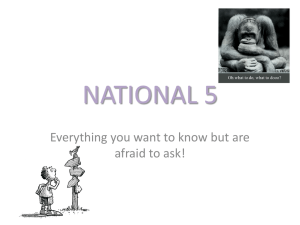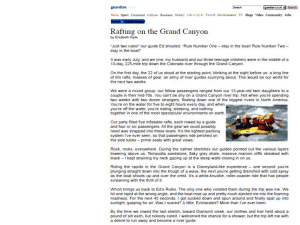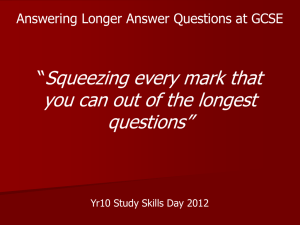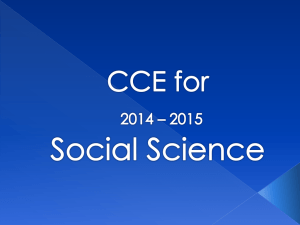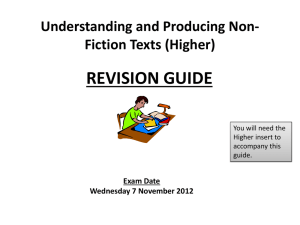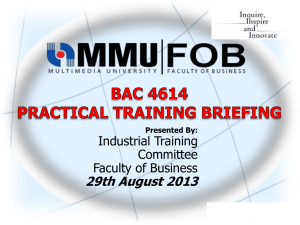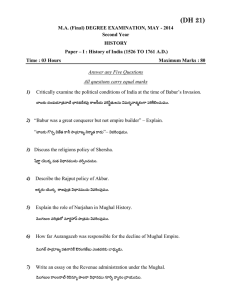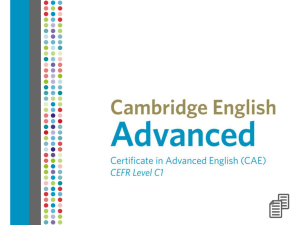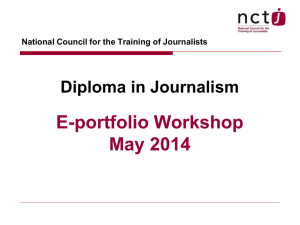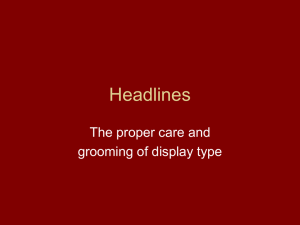English Unit 1 Exam Information for Parents
advertisement
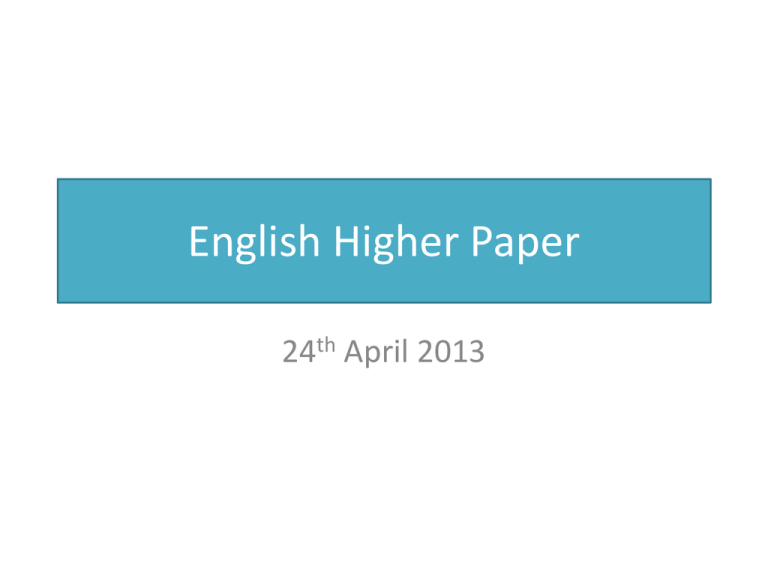
English Higher Paper 24th April 2013 Unit 1 Mocks • Overall a positive picture • Students clearly demonstrated that they have the skills to succeed on the paper • Particularly strong on Q6 • Similar issues to last year – students aren’t demonstrating the skills in the right places Important things to remember • • • • • 80 marks 1.5 minutes per mark Read the question carefully Only look at the sources the question tells you Spelling, punctuation and capital letters important on Section B • Don’t need to fill EVERY line Anything outside of the box will not be marked Reading section • Read the sources & TAP them • Read the questions & highlight the key words • Re-read the sources annotating for the relevant things (either language or presentation) • 15 mins reading and annotating the texts – pick out relevant features (read the questions first) • 1 hour answering the questions Q1, Q2, Q3 • AQA consider these questions to test the same skills – INTERPRETATION. • In their own words interpretation means: – – – – – – – Inferring meaning from a text Commenting on parts of a text Explaining meaning and implications Using words / ideas other than those in the text ‘Reading between the lines’ Making connections between parts of a text BUT not moving beyond the text Question 1 • What do you understand about Sophie Haydock’s experience and the issues of homelessness? (8 marks) Question 1 • 8 marks • Point, Evidence & Explanation x 3/4 • Check of your understanding of the text • “What do we learn about…?” • “What does the text tell us about…?” • “What do we find out about…?” • You are turning the important points of the text INTO your own words! Penistone Feedback • The answers were too general in the main. Not focusing on Sophie or homelessness. • A pattern emerging through all papers is the student veering towards a language answer. Trying to analyse language is not required for this answer nor is their own opinion on homelessness. • Students just need to show understanding and back up with quotes. Question 1 Look at the Mark Scheme for Question 1 • For a mark in Band 3, it states that a candidate ‘begins to interpret the text and make comments about the issues raised…’ • For a mark in Band 4, it states that a candidate ‘makes perceptive connections and comments about the issues raised…’ Here is an example: Question 1 Geoffrey Lean’s article well explains the issues of rainfall and flooding in Britain. In the second paragraph, he writes, ‘South East England has less water per head than any of the places above (by this he means the Middle East and Africa). Lean continues writing that the North and West normally get plenty of rain, often more than they want - but the south and East receive less than some parts of the Mediterranean. Furthermore, this is worrying because the south and east are the most populated part of the country, therefore the places that need the most water. Additionally, ‘global warming is expected to sharpen the dampness divide in the next 70, increasing rainfall sharply in the wet part of the country and cutting it by as much as half in the south and east’. Therefore, the rainfall supplies will be getting even smaller in the places that need it most. Lean also writes that half of the housing built in Britain since the second world war is prone to flooding. Furthermore, he writes that ‘flooding is twice as frequent as it was 100 years ago’. This is worrying as the houses prone to flooding will undoubtedly suffer this change. Question 1 • The underlined parts of the candidate’s answer are interpreted • They are not words taken from the text. They are her own words which show ‘what she has learned from the text’ by making inferences, connections, and reading between the lines Question 1 • It is also important to note that the candidate has not included any new Information • All of her interpretations have been derived from the text and only from the Text • This answer shows clear understanding, clear interpretations are made and there are relevant quotations. Band 3, 6 marks (S4) Question 2 • • • • 8 marks PEE x 3 Will name presentation techniques to explore You MUST link those techniques to the text (language techniques) • Say why specified features are used – nothing else! The………is used to… They are effective because… Question 2 • Now read Source 2, the newspaper story and the picture which goes with it called Homes and crops wrecked, but relief sweeps Queensland in Yasi’s wake by Adam Gabbatt. • 2 Explain how the headline and picture are effective and how they link to the text. (8 marks) Penistone Feedback • Some of the answers were promising but in the main did not link the headline to specific parts of the MAIN text. • Many linked the headline to the picture which was NOT asked for. • Some students identified good things in the headline and the photograph, but did not link to text. • Instead they said things like‘ the picture is one of devastation and we see this in the text ‘ The better answers chose textual evidence to back this up. Question 2 Now look at the Mark Scheme for Question 2 • Question 2 asks candidates to ‘Explain’ Because this skill is part of the question, the requirement appears in all of the mark bands • To ‘explain’ how the headline is effective, a candidate would first need to select some words and devices used, then interpret ways in which these make an impression on the reader • In Question 2, the picture is a focus of the question. It, too, requires interpretation Here are some examples: Question 2 1. Litchfield begins the article with a short, punchy headline, ‘Four amputations,13 hours, one swim’ to intrigue the reader. The way that we read the headline almost feels like it is a countdown, a countdown expressing how little time it took Croizon to finish the swim. 2. The colours used in the photograph contrast each other, the murky green of the water creates a sombre feel, linking to the text in the sense that Litchfield wants the reader to feel sincere empathy for Croizon. In contrast to this, the yellow vest Croizon wears is a symbol of hope, this links to the content of the text as it conveys a sense of achievement, ‘I did it. I’m so happy’, Croizon states. The first example interprets the effect of the headline on the reader. The second interprets the meaning of elements of the picture and then explains how these link to the text with a reference and a specific quotation. Here is another example: Question 2 The words ‘four amputations’ in the title amazes the reader as we wonder how he did it with little muscle to propel himself along. Later in the text it compares how long a normal person would take, ‘8 hours’, then we are astounded that Croizon did it in ‘13 hours and a half’ only five hours slower than average. The word ‘extraordinary’ in the title relates to this as well, as his success is an amazing thing. The candidates are showing skill in a number of the ways we designated to be ‘Interpretation’, here related to the effect on the reader: • Inferring meaning from a text • Commenting on parts of a text • Explaining meaning and implications • Using words / ideas other than those in the text • ‘Reading between the lines’ • Making connections between parts of a text Question 3 • • • • 8 marks PEE x4 Thoughts and feelings, effects of text Tests exactly the same skills as Q1, Q2 and Q3 but requires quotation The character thinks/feels… The effect is… This tells us… Question 3 • Now read Source 3, War-time Homes which is an extract from a non-fiction book by Michael Caine. • 3 Explain some of the thoughts and feelings Michael Caine has about the places where he lived during the war. (8 marks) Penistone Feedback • Nationally this question was less successfully answered (worse than previous years) • Many Penistone students did not identify or pick up on Michael’s feelings and specific thoughts. • There was a lot of narrative copying. • Many talked about effect on reader NOT asked for. Some only mentioned the ‘cruel house ‘ and missed the Norfolk part of his feelings of happiness. • Again MANY talked about language features such as ‘The simile of a Sunflower’ Ironically they did NOT repeat this in Q4 where it would have gained them marks. • If the questions had been reversed then the grades would have been higher. As an examiner you just mark what is there and cannot deviate. This is why the papers frustrated me so much. I knew the students had the knowledge and skills, but were applying it to the wrong questions. Question 3 Look at the Mark Scheme for Question 3 • Mark Bands 4 and 3 require explanation and interpretation. This means that candidates have to find thoughts and feelings, say what they are and then say something about them • For Mark Band 2 thoughts and feelings need to be found with some comments or an attempt at interpreting made • Mark Band 1 requires a limited response Here are some examples: Question 3 Ondaatje clearly loves the environment he is in, because he uses lots of positive adjectives to describe it, such as ‘vibrant’. He seems amazed by what he can see and thinks of it as moving and breathing, as he tells us the African city ‘seemed to grow even as we watched it’ A perceptive explanation and interpretation. At the start it seemed that he was very happy and quite cheerful and chirpy about his experience, ‘it was a wonderful way to wake up.’ This shows he is pleased with his experience so far. Clearly interprets feelings. He says ‘The fish eagles screeched their mocking cry. It was a wonderful way to wake up.’ This shows he is feeling good. Selection with ‘some’ comment to explain. Question 3 • Often candidates use ‘language’ points. These are only relevant when used to explain or interpret the writer’s thoughts and feelings. • Note also that this question is not about the effects on the reader • The reader does not come into this question Question 4 • • • • • • • 16 marks PEE x 4 - 5 Similarities AND differences Language devices Text A uses…an example is…this tells us… Text B also used…an example is…this tells us… However, text A only uses an…an example is…this tells us… Question 4 • Now you need to refer to Source 3, War-time Homes, and either Source 1 or Source 2. You are going to compare two texts, one of which you have chosen. • 4 Compare the ways in which language is used for effect in the two texts. Give some examples and analyse the effects. (16 marks) Penistone Feedback • Many students talked too generally about content, audience and presentation. • There was comparison but not many compared language features. Many just compared the articles. There was little expanding on effect of words and connotations. This was, again, a national issue. • The irony again is, that language features are clearly taught, but the students need to know which question to put this in. I had read so many language answers to Q1 and 3 I was disappointed they were not addressed on the ACTUAL language answer. • It is worth so many marks it would be worth having master classes on this question alone. Question 4 • Question 4 requires candidates to show two skills: • analyse language • compare • Whilst some candidates respond successfully to this question, too many do not • Item analysis shows that only 23.1% of candidates in January achieved 10 marks or better out of 16 for this question Question 4 • Question 4 requires candidates to show evidence of two skills: • analyse language • compare • The Mark Scheme shows that there are still four Mark Bands but the available highest mark is 16 Question 4 • Many candidates find it difficult to achieve marks in the higher bands for this question. • Weaknesses include: • not writing about language at all, rather commenting on, e.g. audience, purpose, content or sentence structure • making generalised comments about language, e.g. that it is ‘formal’ or ‘informal’ • selecting weak examples, e.g. dwelling on the use of pronouns • noting, often erroneously, the ‘person’ or ‘voice’ of the writing • simply identifying ‘fact’ and ‘opinion’ • offering no, or spurious, comparisons Here is an example of a Question 4 response Read it and use the Mark Scheme to put it in a Mark Band Question 4 Both sources 1 and 3 are about water. Both sources use descriptive language. In Source 1 ‘Soggy nation’ and in Source 3 ‘An idyllic spot’. Both sources are informal because they use pronouns, ‘I, he, us, we’. In contrast both sources are quite different. Source 1 is about the dangers of water and flooding where as Source 3 is about the beauty of water and going on a ferry. Source 1 is full of facts and statistics but source 3 is more opinions and descriptive. Both sources have a sense of alarm about them. Source 1 ‘already flooding is twice as frequent as it was 100 years ago’. And again similarly in Source 3 ‘people were killed. How do they gauge the weight?’ Both the sources use emotive language to relate to the reader, by portraying an image in their minds. Source 1, ‘Think of countries that don’t have enough water and your mind might fly to arid, largely desert nations…’ And Source 3 ‘Our tents were pitched right at the water’s edge. Water hyacinths floated in front of us..’ both suggests imagery in your mind. Question 4 Good selection, not developed Aware of the need to compare but content, not language Content Default comment about language Not ‘emotive’ Both sources 1 and 3 are about water. Both sources use descriptive language. In Source 1 ‘Soggy nation’ and in Source 3 ‘An idyllic spot’. Both sources are informal because they use pronouns, ‘I, he, us, we’. In contrast both sources are quite different. Source 1 is about the dangers of water and flooding where as Source 3 is about the beauty of water and going on a ferry. Source 1 is full of facts and statistics but source 3 is more opinions and descriptive. Both sources have a sense of alarm about them. Source 1 ‘already flooding is twice as frequent as it was 100 years ago’. And again similarly in Source 3 ‘people were killed. How do they gauge the weight?’ Both the sources use emotive language to relate to the reader, by portraying an image in their minds. Source 1, ‘Think of countries that don’t have enough water and your mind might fly to arid, largely desert nations…’ And Source 3 ‘Our tents were pitched right at the water’s edge. Water hyacinths floated in front of us..’ both suggests imagery in your mind. General comment Mentions fact and opinion but not as a language point Possibly ‘emotive’ but there is no explanation or interpretation as to how or why. Low level interpretation of effect Question 4 • For her other Reading questions, this candidate achieved at least half marks in each case (4 or 5 out of 8) • This response is an attempt at the question; as such it would be placed in Band 2 Discussion: What could be done with this answer to improve it? Question 4 Both sources 1 and 3 are about water. Both sources use descriptive language. In Source 1 ‘Soggy nation’ and in Source 3 ‘An idyllic spot’. Both sources are informal because they use pronouns, ‘I, he, us, we’. In contrast both sources are quite different. Source 1 is about the dangers of water and flooding where as Source 3 is about the beauty of water and going on a ferry. Source 1 is full of facts and statistics but source 3 is more opinions and descriptive. As it stands, this paragraph Both sources have a sense of alarm about them. Source 1 is ‘content’. The words, ‘flooding’, ‘frequent’, ‘killed’ ‘already flooding is twice as frequent as it was 100 years ago’. need a focus, comment And again similarly in Source 3 ‘people were killed. How do they and interpretation. The gauge the weight?’ idea of ‘alarm’ is good, but wasted. Both the sources use emotive language to relate to the reader, by portraying an image in their minds. Source 1, ‘Think of Much could be made of this countries that don’t have enough water and your mind might phrase.. fly to arid, largely desert nations…’ And Source 3 ‘Our tents and this word were pitched right at the water’s edge. Water hyacinths floated and this phrase in front of us..’ both suggests imagery in your mind. Explain what ‘soggy’ means with an everyday example. Ditto ‘idyllic’. Comment that the effects of the words are different. This is meaningless Quote words from the texts to exemplify danger and beauty. Then interpret the effects The point about factual language is valid, but not without an example. This is not an interpretation. Writing section • Must TAP the QUESTION (not the text) • Highlighting key parts of the question • Punctuation and technical accuracy –commas, capital letters and apostrophes – Shorter writing – 4 marks for technical accuracy – Longer writing – 8 marks for technical accuracy • Shorter writing – 30 minutes • Longer writing – 40 minutes Do the longer writing task first Shorter writing • 16 marks – 4 marks for spelling, punctuation, capital letters • Know your TAP – purpose, audience and text type • Aim to write 1 to 2 sides • Explain, inform, describe • BBC Skillswise: http://www.bbc.co.uk/skillswise/english What AQA Say: • The phrase shorter writing task means that Question 5 should be succinct and focused. • With a suggested length of about 2.5 sides of the answer booklet, this should be shorter than the more sustained response to Question 6. • The phrase write to inform, explain, describe derives from the triplet. Any combination of these purposes may be asked for. • It is worth remembering that the title of this Specification is Understanding and Producing Non-fiction Texts. • Although it is sometimes necessary for candidates to invent scenarios or characters to make their writing effective, flights of narrative fancy are ill-advised. Q5 • The travel section of your local newspaper is inviting readers to write about their favourite place. • Write a letter to the editor describing a favourite place you know and explaining why others would like it. (16 marks) Penistone Feedback • Shorter Writing. Hardly any students wrote to describe. Some did explain but most answers were like persuade or inform. • Some were like a travel brochure. • The describe question can be problematic, but students need to know the different types of writing and how it may present on the shorter question. • Some were longer than Q6. • Some used a letter format which was good. • Technical accuracy is an issue. At the higher end it was better, but lower down sentence structure was poor. Lack of paragraphs and apostrophes. Even capital letters on names were missing which is not a good sign, even on a Foundation paper. (‘disneyland’ etc ) Longer writing • 24 marks – 8 marks for spelling, punctuation and capital letters • Know your TAP – purpose, audience and text type • Aim for 2 to 3 sides • Persuade or argue Q6 • A recent report states: ‘Homelessness in the UK is a crisis that is destroying the lives of people, especially young people.’ • Write an article for your school or college newspaper persuading young people to support charities which help the homeless. (24 marks) Penistone Feedback • Much better and I enjoyed marking these. Good tone and content and length in the main. • Still some technical errors but not as bad. Foundation Feedback • Question 1 and 2 were generally good. • Q3 was the language and again, like the higher paper students talked about writer’s purpose and did not explore effects of language. • Q4. This was the main problem area. The skills are simple. Layout, colour and pictures and their effect. Hardly any students did this. Worth 12 marks, it is simple to rectify and would have meant many more C and above grades/UMS marks. We had a real push at Thrybergh on this question and the January results reflect this. • Q5 and 6 were generally good but technical issues as per Higher tier. Paragraphs and apostrophes as well as a variety of sentences would help. Foundation Feedback • Some of the presentation/handwriting was hard to read. Whilst students are not marked on this, it does give an instant impression. Some seemed rushed and lacked attention to detail. One student’s paper was so difficult to read ( and I mark thousands a year ) I suggest his work is scribed or transcribed. ( Oliver English cand 8353 ) • Candidates sat the November entry paper. Most were entered for the higher tier. It is only my opinion, however I do not think some of the students are Higher tier candidates and would find the foundation more accessible. There are 83 UMS available on this paper, and at our school Plan? • ‘Borrow’ 4 lessons for paper training. • Staff focus on 1 question – spend 45 minutes training the class. Class then move another teacher and spend 10 minutes explaining what they’ve learned (how?) • Following lesson class move on to a different teacher and are trained on another Q. Format repeated for Section A. Plan • ‘Borrow’ 1 or 2 lessons for discrete technical lessons. • Quick tour through punctuation, capitalisation of proper nouns etc. • Who could create these? Ideas? • Suggestions?
